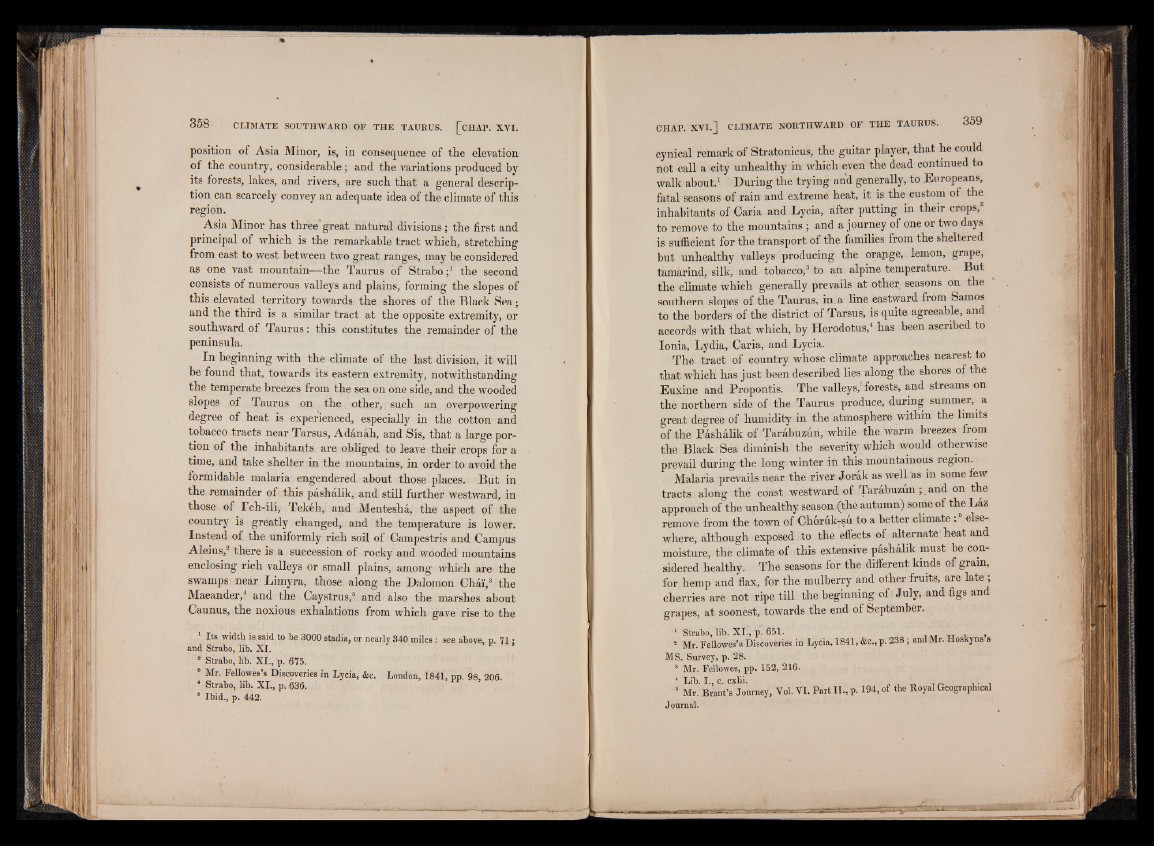
position of Asia Minor, is, in consequence of the elevation
of the country, considerable; and the variations produced by
its forests, lakes, and rivers, are such that a general description
can scarcely convey an adequate idea of the climate of this
region.
Asia Minor has three great natural divisions; the first and
principal of which is the remarkable tract which, stretching
from east to west between two great ranges, may be considered
a§ one vast mountain—the Taurus of Strabo;1 the second
consists of numerous valleys and plains, forming the slopes of
this elevated territory towards the shores of the Black Sea;
and the third is a similar tract at the opposite extremity, or
southward of Taurus: this constitutes the remainder of the
peninsula.
In beginning with the climate of the last division, it will
be found that, towards its eastern extremity, notwithstanding
the temperate breezes from the sea on one side, and the wooded
slopes of Taurus on the other, such an overpowering
degree of heat is experienced, especially in the cotton and
tobacco tracts near Tarsus, Adanah, and Sis, that a large portion
of the inhabitants are obliged to leave their crops for a
time, and take shelter in the mountains, in order to avoid the
formidable malaria engendered about those places. But in
the remainder of this pashalik, and still further westward, in
those of Ich-ili, Tekeh, and Mentesha, the aspect of the
country is greatly changed, and the temperature is lower.
Instead of the uniformly rich soil of Campestris and Campus
Aleius,2 there is a succession of rocky and wooded mountains
enclosing rich valleys or small plains, among which are the
swamps near Liinyra, those along the Dalomon Chai,3 the
Maeander,4 and the Caystrus,! and also the marshes about
Caunus, the noxious exhalations from which gave rise to the
Its width is said to he 3000 stadia, or nearly 340 miles • see above, p. 71 *
and Strabo, lib. XI.
s Strabo, lib. XI., p. 675.
8 Mr. Fellowes’s Discoveries in Lycia, &c. London, 1841, pp. 98, 206
4 Strabo, lib. XI., p. 636.
8 Ibid., p. 442.
cynical remark of Stratonicus, the guitar player, that he could
not call a city unhealthy in which even the dead continued to
walk about.1 During the trying an'd generally, to Europeans,
fatal seasons of rain and extreme heat, it is the custom of the
inhabitants of Caria and Lycia, after putting in their crops,
to remove to the mountains ; and a journey of one or two days
is sufficient for the transport of the families from the sheltered
but unhealthy valleys producing the orange, lemon, grape,
tamarind, silk, and tobacco,3 to an alpine temperature. But
the climate which generally prevails at other seasons on the
southern slopes of the Taurus, in, a line eastward from Samos
to the borders of the district of Tarsus, is quite agreeable, and
accords with that which, by Herodotus,4 has been ascribed to
Ionia, Lydia, Caria, and Lycia.
The tract of country whose climate approaches Dearest to
that which has just been described lies along the shores of the
Euxine and Propontis. The valleys/forests, and streams on
the northern side of the Taurus produce, during summer, a
great degree of humidity in the atmosphere within the limits
of the Pashalik of Tarabuzun, while the warm breezes from
the Black ! Sea diminish the severity which would otherwise
prevail during the long winter in this mountainous region.
Malaria prevails near the river Jorak as well as in some few
tracts along the coast westward of Tarabuzun; and on the
approach of the unhealthy season (the autumn) some of the Laz
remove from the town of Ch6ruk-su to a better climate . elsewhere,
although exposed to the effects of alternate heat and
moisture, the climate of this extensive pashalik must be considered
healthy. . The seasons for the different kinds of grain,
for hemp and flax, for the mulberry and other fruits, are late ;
cherries are not ripe till the beginning o f; July, and figs and
grapes, at soonest, towards the end of September.
1 Strabo, lib. XI., p. 651. _ ,
* M r . F e l l o w e s ’ s Discoveries in Lycia, 1841, &c., p. 238; and Mr. Hoskyns s
MS. Survey, p. 28.
8 Mr. Fellowes, pp. 152, 216.
4 Lib. I., c. cxlii. H tirfgSidfeS , . ,
5 Mr. Brant’s Journey, Vol. VI. Part II., p. 194, of tbe Royal Geographical
Journal.